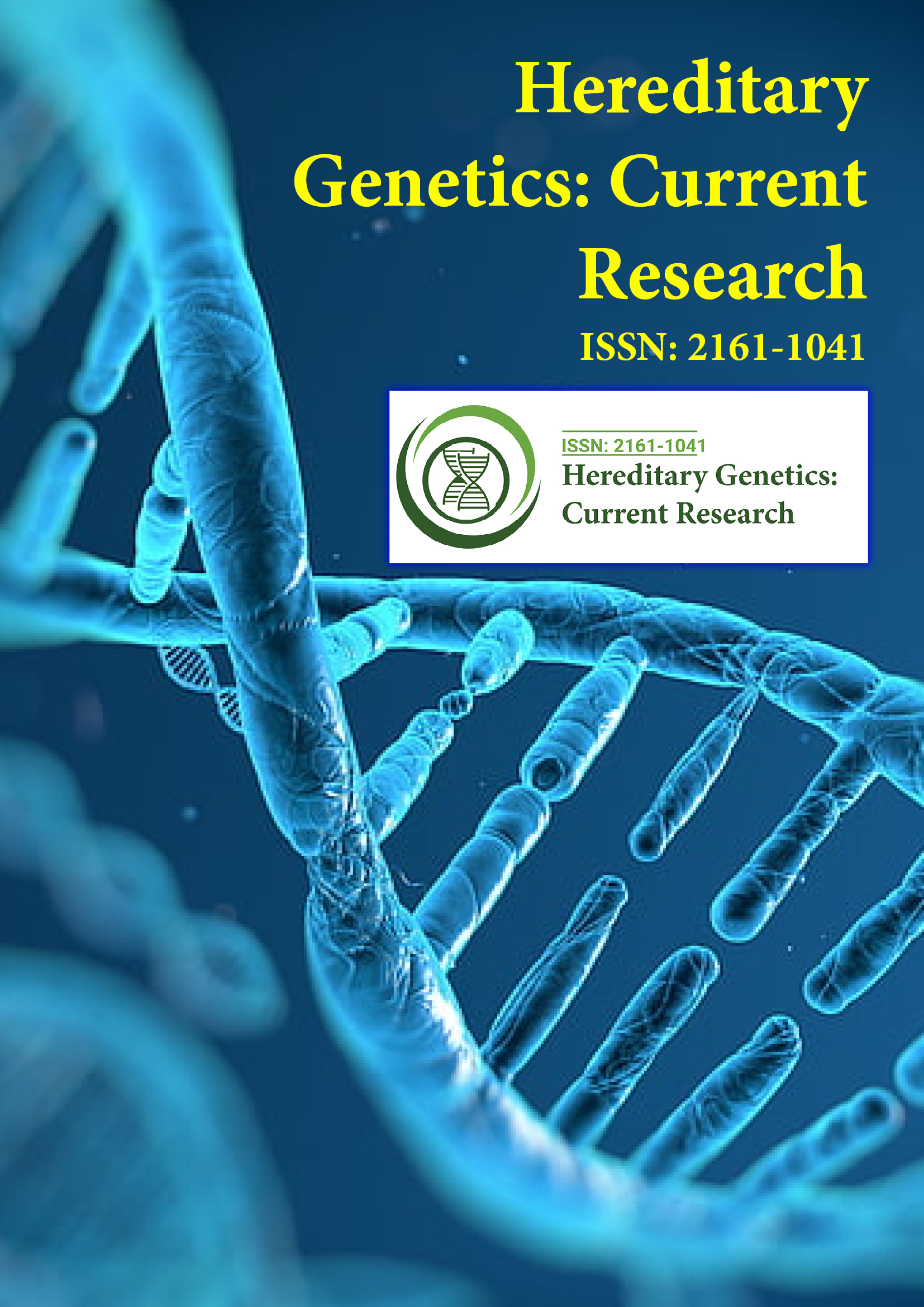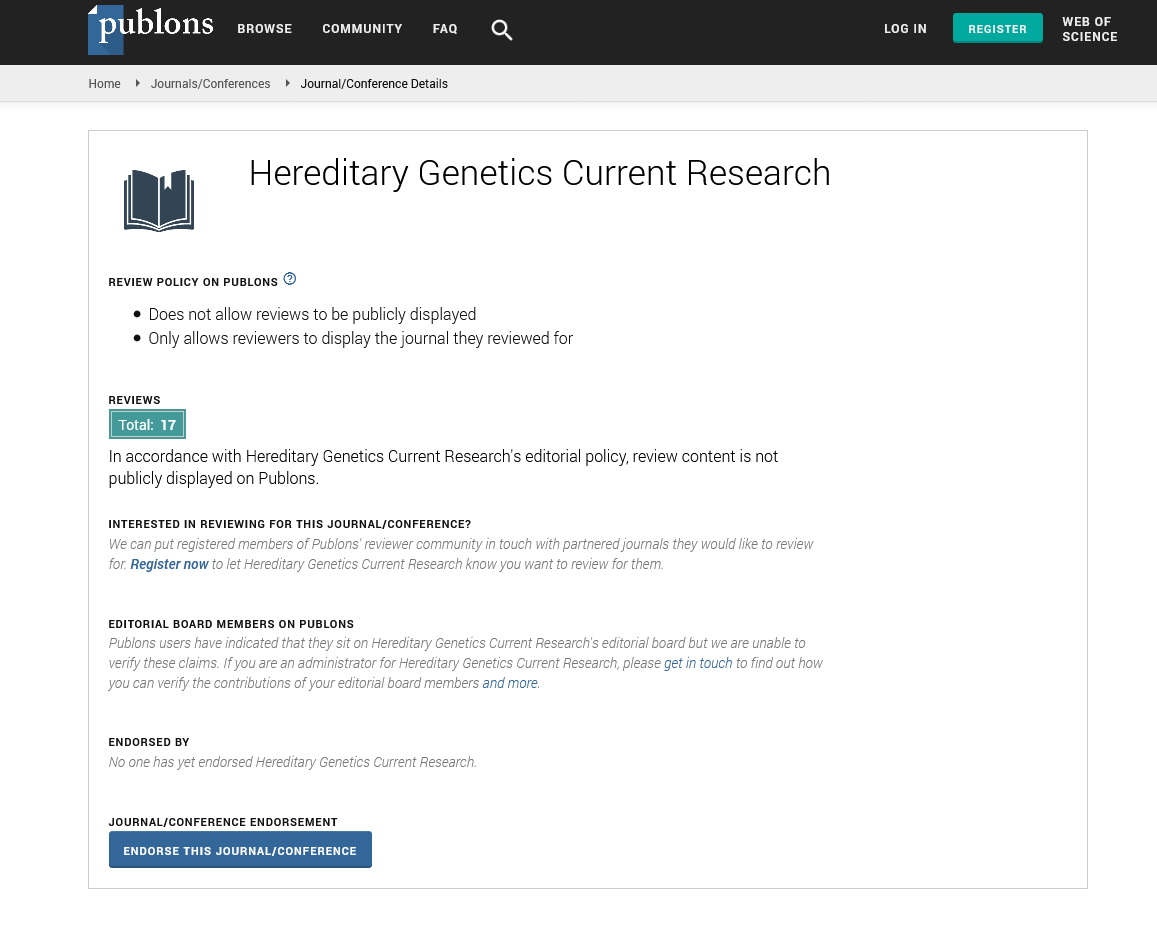Indexed In
- Open J Gate
- Genamics JournalSeek
- CiteFactor
- RefSeek
- Hamdard University
- EBSCO A-Z
- NSD - Norwegian Centre for Research Data
- OCLC- WorldCat
- Publons
- Geneva Foundation for Medical Education and Research
- Euro Pub
- Google Scholar
Useful Links
Share This Page
Journal Flyer

Open Access Journals
- Agri and Aquaculture
- Biochemistry
- Bioinformatics & Systems Biology
- Business & Management
- Chemistry
- Clinical Sciences
- Engineering
- Food & Nutrition
- General Science
- Genetics & Molecular Biology
- Immunology & Microbiology
- Medical Sciences
- Neuroscience & Psychology
- Nursing & Health Care
- Pharmaceutical Sciences
Commentary Article - (2024) Volume 13, Issue 3
Hereditary Cancer Syndromes Associating Biology and Clinical Genetics
Wen Hang*Received: 30-Sep-2024, Manuscript No. HGCR-24-28208; , Pre QC No. HGCR-24-28208 (PQ); Reviewed: 16-Aug-2024, QC No. QC HGCR-24-28208 ; Revised: 23-Aug-2024, Manuscript No. HGCR-24-28208 (R); Published: 30-Aug-2024, DOI: 10.35248/2161-1041.24.13.291
Description
Hereditary cancers account for approximately 5%-10% of all cancers and arise due to germline mutations passed down through generations. These mutations predispose individuals to specific cancer types, often occurring earlier than their sporadic counterparts. Advances in the understanding of the biology and genetics of hereditary cancers have highlighted their fundamental mechanisms, providing methods for early diagnosis, targeted therapy and preventive strategies.
Hereditary cancers are germline mutations in tumor suppressor genes, oncogenes and DNA repair genes. Tumor suppressor genes such as TP53, RB1 and BRCA1/2 are critical for regulating cell growth and maintaining genomic stability. Loss-of-function mutations in these genes impair their protective roles, predisposing cells to uncontrolled proliferation and malignant transformation. For example, mutations in BRCA1 and BRCA2 are characteristics of hereditary breast and ovarian cancer syndromes, imparting significantly increased lifetime risks for these cancers.
Oncogenes, when activated by gain-of-function mutations, drive cancer progression by promoting cell growth and survival. Although less commonly implicated in hereditary cancers, examples include mutations in the RET proto-oncogene, associated with Multiple Endocrine Neoplasia Type 2 (MEN2).
A third major category involves genes responsible for DNA repair, such as MLH1, MSH2, MSH6 and PMS2, which are associated with Lynch syndrome. Mutations in these genes lead to microsatellite instability, a characteristic of tumors arising in Hereditary Nonpolyposis Colorectal Cancer (HNPCC). The inability to repair DNA damage effectively contributes to the accumulation of mutations, driving cancer development.
The biological mechanisms of hereditary cancers are often framed by Knudson’s "two-hit hypothesis." This model posits that an individual with a germline mutation in a tumor suppressor gene (the "first hit") requires a second, somatic mutation (the "second hit") in the same gene for tumor formation. This hypothesis elegantly explains the early onset and high penetrance observed in many hereditary cancer syndromes.
Recent advances in genetic technologies have expanded the scope of hereditary cancer genetics. Whole-Exome Sequencing (WES) and Whole-Genome Sequencing (WGS) have uncovered novel genes associated with cancer predisposition, including PALB2, RAD51C and RAD51D in breast and ovarian cancers and SDHB and SDHD in hereditary paragangliomas and pheochromocytomas. These discoveries have broadened our understanding of the genetic heterogeneity fundamental hereditary cancers and highlighted the importance of considering rare variants in genetic testing.
Epigenetics also plays an essential role in hereditary cancers, complementing the effects of germline mutations. Epigenetic modifications, such as DNA methylation and chromatin acetylation, can silence tumor suppressor genes without altering the underlying DNA sequence. For example, promoter hypermethylation of MLH1 is a common mechanism in Lynch syndrome-associated tumors, contributing to the loss of DNA mismatch repair function.
Clinical management of hereditary cancers depends on early diagnosis and risk stratification, facilitated by genetic testing. Identifying germline mutations in high-risk genes enables the implementation of tailored surveillance and prevention strategies. For example, carriers of BRCA1/2 mutations may undergo enhanced screening with MRI, prophylactic surgeries, or chemoprevention to reduce cancer risk. Similarly, individuals with Lynch syndrome benefit from regular colonoscopies and, in some cases, prophylactic hysterectomy to prevent endometrial cancer. Genetic counseling is a combined component of hereditary cancer care, guiding individuals and families through the implications of genetic testing. Counseling addresses the psychological and ethical dimensions of hereditary cancer risk, including the potential for incidental findings and the implications for family members.
Conclusion
The biology and genetics of hereditary cancers explain the complex exchange between inherited mutations, molecular mechanisms and clinical care. Advances in genetic testing and targeted therapies have transformed the environment of hereditary cancer management, providing hope for improved outcomes and prevention. Continued research and collaboration are essential to unlocking the full potential of these discoveries, ensuring that the benefits of genomic medicine extend to all affected by hereditary cancers.
Citation: Hang W (2024). Hereditary Cancer Syndromes Associating Biology and Clinical Genetics. Hereditary Genet. 13:291.
Copyright: © 2024 Hang W. This is an open accessarticle distributed under the terms of the Creative Commons Attribution License, which permits unrestricted use, distribution, and reproduction in any medium, provided the original author and source are credited.

